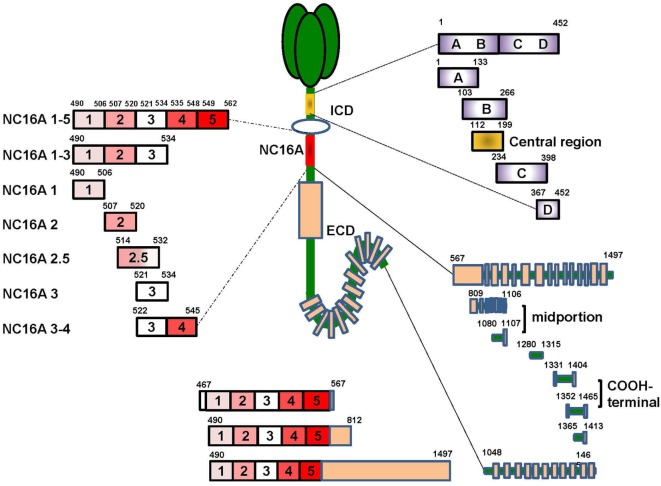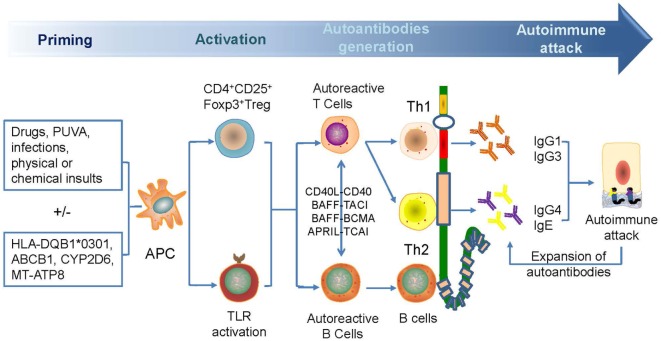BP180 Is Critical in the Autoimmunity of Bullous Pemphigoid
Bullous pemphigoid (BP) is by far the most common autoimmune blistering dermatosis that mainly occurs in the elderly. The BP180 is a transmembrane glycoprotein, which is highly immunodominant in BP. The structure and location of BP180 indicate that it is a significant autoantigen and plays a key role in blister formation. Autoantibodies from BP patients react with BP180, which leads to its degradation and this has been regarded as the central event in BP pathogenesis. The consequent blister formation involves the activation of complement-dependent or -independent signals, as well as inflammatory pathways induced by BP180/anti-BP180 autoantibody interaction.
One typical serologic characteristic of BP is the presence of circulating autoantibodies, which are mostly against BP180 (collagen XVII) and BP230 (15, 19, 20). BP180 is a 180 kDa transmembrane glycoprotein with a 16th non-collagenous (NC16A) domain, which is the immunodominant part in BP (14). BP230 is an intracellular constituent of the hemidesmosomal plaque and belongs to the spectraplakin famil
BP180 is a type II transmembrane protein with a cytosolic NH2 terminal and an extracellular COOH domain (47). The N-terminal domain, transmembranous stretch, and extracellular C-terminus have 466, 23, and 1,008 amino acids (aa) in length, respectively (48). The ectodomain contains 15 collagenous subdomains (COL1–COL15) interspersed by 16 non-collagenous sequences (NC1–NC16). The NC16A domain, a juxtamembranous linker region, appears to be biologically important, as it serves as the nucleus for the formation of a collagen-like triple helix (49, 50). The extracellular domain contains coiled-coil structures, which are physiologically shed from the cell surface by a disintegrin metalloproteinase (ADAM) (50). The ectodomain forms a loop structure as it spans the lamina lucida, extends to lamina densa, and then kinks back into the lamina lucida (49). BP180 contains multiple binding sites for hemidesmosome proteins, including the extracellular domains of integrin α6 and laminin-332 (laminin-5) and the cytoplasmic domains of integrin β4, plectin, and BP230 (20). The structure and location of BP180 indicate that it acts as a core anchor protein that connects the intracellular and extracellular hemidesmosomal proteins and plays a key role in the pathogenesis of BP.


Table 1.
Potential treatment targets for bullous pemphigoid (BP).
| Categories | Targets | Drugs or methods | Potential effects | Reference |
|---|---|---|---|---|
| Immune tolerance | Regulatory T (Treg) cells | Interleukin (IL)-10 | Increasing Treg cells | (171) |
| Low-dose IL-2 | Inducing significant Treg cells expansion | (172, 173) | ||
| Oxymatrine | Upregulating FOXP3 Treg cells and reducing the production of tumor necrosis factor-α and IL-17A | (174) | ||
| BP180 NC16A | Gene gun delivery of NC16a-encoding DNA | Inducting tolerance of BP180 | (175) | |
| BP180 | Lactic-co-glycolic acid nanoparticles | Inducing antigen-specific T cell tolerance | (176) | |
| B cells | CD20 | Rituximab | Reducing all subclasses of immunoglobulin G (IgG) anti-BP180 autoantibodies | (102, 177) |
| Rituximab and intravenous immunoglobulin | Producing a prolonged and sustained remission in patients with active and recalcitrant BP | (39, 178) | ||
| Calcineurin inhibitors | Suppressing naive B cells | (179) | ||
| T cells | CD25 | Anti-CD25 antibodies | Targeting IL-2 receptor on activated T cells | (180) |
| Calcineurin | Calcineurin inhibitors | Inhibiting nuclear factor of activated T cells and blocking T-cell-dependent production of IgG | (181) | |
| CD4+ T cells | IL-10 | Lowering the number of circulating CD4+ T cells | (171) | |
| Co-stimulators | BAFF–APRIL | Tabaluma (anti-BAFF) | Neutralizing autoreactive and memory B cells | (182) |
| Anti-APRIL | Anti-proliferation and reducing autoantibodies production | (183, 184) | ||
| CD40–CD40L | Anti-CD40 | Regulating both innate and adaptive immunity and the activation of antigen-specific T cells | (185) | |
| Autoantibodies | IgG | SM101 | A soluble FcγR that competes with the interaction of IgG with membrane FcγRs | (186) |
| IgE | Omalizumab | Inhibiting IgE binding to FcεRI | (108) | |
| Autoantibodies | Immunoadsorption | Declining the serum autoantibody levels | (187, 188) | |
APRIL, a proliferation-inducing ligand; BAFF, B-cell activating factor.





